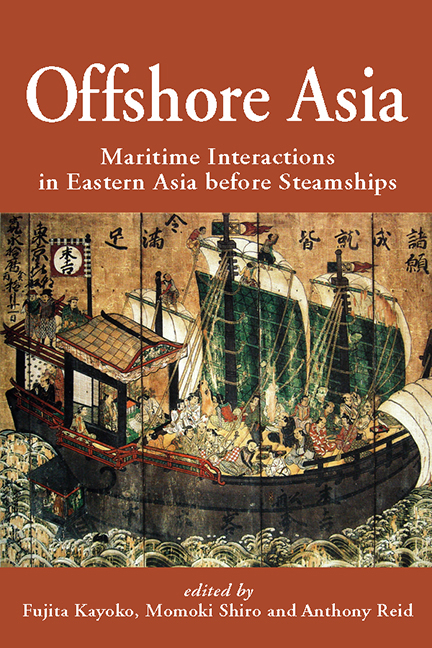Book contents
- Frontmatter
- Contents
- Maps
- Tables and Figures
- Preface
- Contributors
- Map 1 Eastern Asia in the 13th–16th Centuries
- 1 Introduction: Maritime Interactions in Eastern Asia
- 2 The Periodization of Southeast Asian History, in Comparison with that of Northeast Asia
- 3 Merchants, Envoys, Brokers and Pirates: Hokkien Connections in Pre-modern Maritime Asia
- 4 An Asian Commercial Ecumene, 900–1300 ce
- 5 The Japanese Archipelago and Maritime Asia from the 9th to the 14th Centuries
- 6 Saltpetre Trade and Warfare in Early Modern Asia
- 7 Shaping Maritime East Asia in the 15th and 16th Centuries through Choson Korea
- 8 Shipwreck Salvage and Survivors’ Repatriation Networks of the East Asian Rim in the Qing Dynasty
- 9 Wei Zhiyan and the Subversion of the Sakoku
- 10 Metal Exports and Textile Imports of Tokugawa Japan in the 17th Century: The South Asian Connection
- Bibliography of Works Cited
- Index
- NALANDA-SRIWIJAYA SERIES
6 - Saltpetre Trade and Warfare in Early Modern Asia
Published online by Cambridge University Press: 21 October 2015
- Frontmatter
- Contents
- Maps
- Tables and Figures
- Preface
- Contributors
- Map 1 Eastern Asia in the 13th–16th Centuries
- 1 Introduction: Maritime Interactions in Eastern Asia
- 2 The Periodization of Southeast Asian History, in Comparison with that of Northeast Asia
- 3 Merchants, Envoys, Brokers and Pirates: Hokkien Connections in Pre-modern Maritime Asia
- 4 An Asian Commercial Ecumene, 900–1300 ce
- 5 The Japanese Archipelago and Maritime Asia from the 9th to the 14th Centuries
- 6 Saltpetre Trade and Warfare in Early Modern Asia
- 7 Shaping Maritime East Asia in the 15th and 16th Centuries through Choson Korea
- 8 Shipwreck Salvage and Survivors’ Repatriation Networks of the East Asian Rim in the Qing Dynasty
- 9 Wei Zhiyan and the Subversion of the Sakoku
- 10 Metal Exports and Textile Imports of Tokugawa Japan in the 17th Century: The South Asian Connection
- Bibliography of Works Cited
- Index
- NALANDA-SRIWIJAYA SERIES
Summary
[Japan] does not produce saltpetre domestically. Nearby [they] trade illegally [for it] with China, while faraway with Siam.
— Zheng Shungong, in Japan in 1555–57Your honoured country's saltpetre is of surprising quality.… I am extremely glad to learn…that by next year's ship you will graciously send me the much desired guns and saltpetre.… These are what I desire more than gold brocade.
— Tokugawa Ieyasu's letters to the king of Siam in 1608 and 1610Gunpowder technology not only changed the nature of warfare, but also changed the trajectory of the early modern world, as Geoffrey Parker has famously argued. Another aspect of the advent of gunpowder technology is that it also changed the way war-making materials were procured. Since the two major materials used to manufacture gunpowder, saltpetre and sulphur, were mostly located in different geographical locations and no one country or region in the early modern world possessed both of them in sufficient quantity to fill its needs for manufactured gunpowder (“black powder”) for waging war, at least one of them had to be procured via trade. Charcoal, the third ingredient, was universally available.
Comparatively speaking, saltpetre played a more important role than sulphur and charcoal in the gunpowder formula. However, existing research on the saltpetre trade has hitherto left much to be desired, especially regarding Asia east of India. For the early modern world (c.1390–1850), saltpetre production and trade have received abundant attention for Europe, the Ottoman empire, and India (especially the trade between India and Europe). Regarding Indian saltpetre, Brenda Buchanan has recognized that acquisition of Indian saltpetre led to the creation of the “British Gunpowder Empire”, while James Frey in his meticulous and global study has argued that it was this Indian saltpetre that made possible the “Military Revolution” in 18th century Europe. Valuable and inspiring as these works are, they are marred by Indocentric views. In Asia east of India, saltpetre refining in Japan and Korea, and saltpetre trade between China, Korea, Japan, Siam and the Philippines, have been treated to some extent, but primarily in Japanese and Korean scholarship; using by and large only Chinese, Korean, and Japanese sources.
- Type
- Chapter
- Information
- Offshore AsiaMaritime Interactions in Eastern Asia before Steamships, pp. 130 - 184Publisher: ISEAS–Yusof Ishak InstitutePrint publication year: 2013

